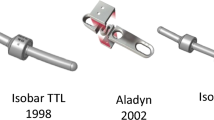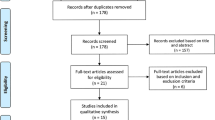Abstract
Lumbar spinal fusion using rigid rods is a common surgical technique. However, adjacent segment disease and other adverse effects can occur. Dynamic stabilization devices preserve physiologic motion and reduce painful stress but have a high rate of construct failure and reoperation. Polyetheretherketone (PEEK) rods for semi-rigid fusions have a similar stiffness and adequate stabilization power compared with titanium rods, but with improved load sharing and reduced mechanical failure. The purpose of this paper is to review and evaluate the clinical and biomechanical performance of PEEK rods. A systematic review of clinical and biomechanical studies was conducted. A literature search using the PubMed, EMBASE, and Cochrane Library databases identified studies that met the eligibility criteria. Eight clinical studies and 15 biomechanical studies were included in this systematic review. The visual analog scale and the Oswestry disability index improved significantly in most studies, with satisfactory fusion rates. The occurrence of adjacent segment disease was low. In biomechanical studies, PEEK rods demonstrated a superior load-sharing distribution, a larger adjacent segment range of motion, and reduced stress at the rod-screw/screw-bone interfaces compared with titanium rods. The PEEK rod construct was simple to assemble and had a reliable in vivo performance compared with dynamic devices. The quality of clinical studies was low with confounding results, although results from mechanical studies were encouraging. There is no evidence strong enough to confirm better outcomes with PEEK rods than titanium rods. More studies with better protocols, a larger sample size, and a longer follow-up time are needed.





Similar content being viewed by others
References
Abode-Iyamah K, Kim SB, Grosland N, Kumar R, Belirgen M, Lim TH, Torner J, Hitchon PW (2014) Spinal motion and intradiscal pressure measurements before and after lumbar spine instrumentation with titanium or PEEK rods. J Clin Neurosci 21:651–655
Ahn YH, Chen WM, Lee KY, Park KW, Lee SJ (2008) Comparison of the load-sharing characteristics between pedicle-based dynamic and rigid rod devices. Biomed Mater 3
Athanasakopoulos M, Mavrogenis AF, Triantafyllopoulos G, Koufos S, Pneumaticos SG (2013) Posterior spinal fusion using pedicle screws. Orthopedics 36:e951–e957
Battie MC, Videman T, Kaprio J, Gibbons LE, Gill K, Manninen H, Saarela J, Peltonen L (2009) The Twin Spine Study: contributions to a changing view of disc degeneration. Spine J : Off J North Am Spine Soc 9:47–59. doi:10.1016/j.spinee.2008.11.011
Bruner HJ, Guan Y, Yoganandan N, Pintar FA, Maiman DJ, Slivka MA (2010) Biomechanics of polyaryletherketone rod composites and titanium rods for posterior lumbosacral instrumentation: presented at the 2010 Joint Spine Section Meeting—Laboratory Investigation. J Neurosurg Spine 13:766–772
Chamoli U, Diwan AD, Tsafnat N (2014) Pedicle screw-based posterior dynamic stabilizers for degenerative spine: in vitro biomechanical testing and clinical outcomes. J Biomed Mater Res A 102:3324–3340. doi:10.1002/jbm.a.34986
Chang TK, Huang CH, Liu YC, Chen WC, McClean CJ, Lai YS, Cheng CK (2013) Biomechanical evaluation and comparison of polyetheretherketone rod system to traditional titanium rod fixation on adjacent levels. Formosan J Musculoskelet Disord 4:42–47
Chou D, Lau D, Skelly A, Ecker E (2011) Dynamic stabilization versus fusion for treatment of degenerative spine conditions. Evidence-Based Spine-Care J 2:33–42. doi:10.1055/s-0030-1267111
Chou WK, Chien A, Wang JL (2014) Biomechanical analysis between PEEK and titanium screw-rods spinal construct subjected to fatigue loading. J Spinal Disord Tech
Colangeli S, Barbanti Brodano G, Gasbarrini A, Bandiera S, Mesfin A, Griffoni C, Boriani S (2015) Polyetheretherketone (PEEK) rods: short-term results in lumbar spine degenerative disease. J Neurosurg Sci 59:91–96
De Iure F, Bosco G, Cappuccio M, Paderni S, Amendola L (2012) Posterior lumbar fusion by peek rods in degenerative spine: preliminary report on 30 cases. Eur Spine J 21:S50–S54
Fritzell P, Hagg O, Nordwall A (2003) Complications in lumbar fusion surgery for chronic low back pain: comparison of three surgical techniques used in a prospective randomized study. A report from the Swedish Lumbar Spine Study Group. Eur Spine J : Off Publ Eur Spine Soc Eur Spinal Deformity Soc Eur Section Cervical Spine Res Soc 12:178–189. doi:10.1007/s00586-002-0493-8
Frost HM (1994) Wolff’s Law and bone’s structural adaptations to mechanical usage: an overview for clinicians. Angle Orthod 64:175–188. doi:10.1043/0003-3219(1994)064<0175:WLABSA>2.0.CO;2
Galbusera F, Bellini CM, Anasetti F, Ciavarro C, Lovi A, Brayda-Bruno M (2011) Rigid and flexible spinal stabilization devices: a biomechanical comparison. Med Eng Phys 33:490–496
Gornet MF, Chan FW, Coleman JC, Murrell B, Nockels RP, Taylor BA, Lanman TH, Ochoa JA (2011) Biomechanical assessment of a PEEK rod system for semi-rigid fixation of lumbar fusion constructs. J Biomech Eng 133
Guyatt GH, Oxman AD, Vist GE, Kunz R, Falck-Ytter Y, Alonso-Coello P, Schunemann HJ (2008) GRADE: an emerging consensus on rating quality of evidence and strength of recommendations. BMJ 336:924–926. doi:10.1136/bmj.39489.470347.AD
Heo DH, Cho YJ, Cho SM, Choi HC, Kang SH (2012) Adjacent segment degeneration after lumbar dynamic stabilization using pedicle screws and a nitinol spring rod system with 2-year minimum follow-up. J Spinal Disord Tech 25:409–414. doi:10.1097/BSD.0b013e318231665d
Highsmith JM, Tumialan LM, Rodts GE, Jr. (2007) Flexible rods and the case for dynamic stabilization. Neurosurg Focus 22
Huang W, Chang Z, Song R, Zhou K, Yu X (2016) Non-fusion procedure using PEEK rod systems for lumbar degenerative diseases: clinical experience with a 2-year follow-up. BMC Musculoskelet Disord 17:53. doi:10.1186/s12891-016-0913-2
Jahng TA, Kim YE, Moon KY (2013) Comparison of the biomechanical effect of pedicle-based dynamic stabilization: a study using finite element analysis. Spine J 13:85–94
Jin YJ, Kim YE, Seo JH, Choi HW, Jahng TA (2013) Effects of rod stiffness and fusion mass on the adjacent segments after floating mono-segmental fusion: a study using finite element analysis. Eur Spine J 22:1066–1077
Kanayama M, Togawa D, Hashimoto T, Shigenobu K, Oha F (2009) Motion-preserving surgery can prevent early breakdown of adjacent segments: comparison of posterior dynamic stabilization with spinal fusion. J Spinal Disord Tech 22:463–467. doi:10.1097/BSD.0b013e3181934512
Kelly MP, Mok JM, Berven S (2010) Dynamic constructs for spinal fusion: an evidence-based review. Orthop Clin North Am 41:203–215. doi:10.1016/j.ocl.2009.12.004
Kumar A, Beastall J, Hughes J, Karadimas EJ, Nicol M, Smith F, Wardlaw D (2008) Disc changes in the bridged and adjacent segments after Dynesys dynamic stabilization system after two years. Spine 33:2909–2914. doi:10.1097/BRS.0b013e31818bdca7
Kurtz SM (2011) PEEK biomaterials handbook. Applications of polyaryletheretherketone in spinal implants. William Andrew
Kurtz SM, Lanman TH, Higgs G, MacDonald DW, Berven SH, Isaza JE, Phillips E, Steinbeck MJ (2013) Retrieval analysis of PEEK rods for posterior fusion and motion preservation. Eur Spine J 22:2752–2759
Lee MJ, Dettori JR, Standaert CJ, Ely CG, Chapman JR (2012) Indication for spinal fusion and the risk of adjacent segment pathology: does reason for fusion affect risk? A systematic review. Spine 37:S40–51. doi:10.1097/BRS.0b013e31826ca9b1
Lehmann TR, Spratt KF, Tozzi JE, Weinstein JN, Reinarz SJ, El-Khoury GY, Colby H (1987) Long-term follow-up of lower lumbar fusion patients. Spine 12:97–104
Liao Z, Chen W, Wang Z-H, Wei H-W (2015) Clinical study of a new transpedicular nonfusion posterior dynamic stabilization system for treating herniated lumbar intervertebral disks. Neurosurg Q 25:4
Lin HM, Pan YN, Liu CL, Huang LY, Huang CH, Chen CS (2013) Biomechanical comparison of the K-ROD and Dynesys dynamic spinal fixator systems—a finite element analysis. Bio-med Mater Eng 23:495–505. doi:10.3233/BME-130766
Mavrogenis AF, Vottis C, Triantafyllopoulos G, Papagelopoulos PJ, Pneumaticos SG (2014) PEEK rod systems for the spine. Eur J Orthop Surg Traumatol 24:S111–S116
Mulholland RC, Sengupta DK (2002) Rationale, principles and experimental evaluation of the concept of soft stabilization. Eur Spine J : Off Publ Eur Spine Soc Eur Spinal Deformity Soc Eur Section Cervical Spine Res Soc 11(Suppl 2):S198–205. doi:10.1007/s00586-002-0422-x
Nockels RP (2005) Dynamic stabilization in the surgical management of painful lumbar spinal disorders. Spine 30:S68–72
Norvell DC, Dettori JR, Skelly AC, Riew KD, Chapman JR, Anderson PA (2012) Methodology for the systematic reviews on an adjacent segment pathology. Spine 37:S10–17. doi:10.1097/BRS.0b013e31826cd9c8
Ormond DR, Albert Jr L, Das K (2012) Polyetheretherketone (PEEK) rods in lumbar spine degenerative disease: a case series. J Spinal Disord Tech
Ponnappan RK, Serhan H, Zarda B, Patel R, Albert T, Vaccaro AR (2009) Biomechanical evaluation and comparison of polyetheretherketone rod system to traditional titanium rod fixation. Spine J 9:263–267
Qi L, Li M, Zhang S, Xue J, Si H (2013) Comparative effectiveness of PEEK rods versus titanium alloy rods in lumbar fusion: a preliminary report. Acta Neurochir 155:1187–1193
Radcliff KE, Kepler CK, Jakoi A, Sidhu GS, Rihn J, Vaccaro AR, Albert TJ, Hilibrand AS (2013) Adjacent segment disease in the lumbar spine following different treatment interventions. Spine J : Off J North Am Spine Soc 13:1339–1349. doi:10.1016/j.spinee.2013.03.020
Sengupta DK, Bucklen B, McAfee PC, Nichols J, Angara R, Khalil S (2013) The comprehensive biomechanics and load-sharing of semirigid PEEK and semirigid posterior dynamic stabilization systems. Adv Orthop 745610:4
Shih K-S, Hsu C-C, Zhou S-Y, Hou S-M (2015) Biomechanical investigation of pedicle screw-based posterior stabilization systems for the treatment of lumbar degenerative disc disease using finite element analyses. Biomed Eng - Appl Basis Commun 27
Turner JL, Paller DJ, Murrell CB (2010) The mechanical effect of commercially pure titanium and polyetheretherketone rods on spinal implants at the operative and adjacent levels. Spine 35:E1076–E1082
Vieweg; U, Grochulla F (2012) Manual of spine surgery. Posterior lumbar interbody fusion with an interbody fusion spacer or cage. Springer
Wang CJ, Graf H, Wei HW (2014) Clinical outcomes of the dynamic lumbar pedicle screw-rod stabilization: 2-year follow-up results. Neurosurg Q
Wang JC, Arnold PM, Hermsmeyer JT, Norvell DC (2012) Do lumbar motion preserving devices reduce the risk of adjacent segment pathology compared with fusion surgery? A systematic review. Spine 37:S133–143. doi:10.1097/BRS.0b013e31826cadf2
Williams FM, Sambrook PN (2011) Neck and back pain and intervertebral disc degeneration: role of occupational factors. Best Pract Res Clin Rheumatol 25:69–79. doi:10.1016/j.berh.2011.01.007
Wright JG, Swiontkowski MF, Heckman JD (2003) Introducing levels of evidence to the journal. J Bone Joint Surg Am 85-A:1–3
Yang M, Li C, Chen Z, Bai Y, Li M (2014) Short term outcome of posterior dynamic stabilization system in degenerative lumbar diseases. Indian J Orthop 48:574–581. doi:10.4103/0019-5413.144222
Author information
Authors and Affiliations
Corresponding author
Ethics declarations
Disclosure
None of the authors received financial support for this study.
Additional information
Strength of recommendation
Low (due to the majority of clinical studies being level III or below)
Rights and permissions
About this article
Cite this article
Li, C., Liu, L., Shi, JY. et al. Clinical and biomechanical researches of polyetheretherketone (PEEK) rods for semi-rigid lumbar fusion: a systematic review. Neurosurg Rev 41, 375–389 (2018). https://doi.org/10.1007/s10143-016-0763-2
Received:
Revised:
Accepted:
Published:
Issue Date:
DOI: https://doi.org/10.1007/s10143-016-0763-2




